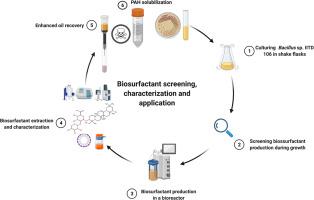Journal of Hazardous Materials ( IF 12.2 ) Pub Date : 2021-09-15 , DOI: 10.1016/j.jhazmat.2021.127201 Arif Nissar Zargar 1 , Anna Lymperatou 2 , Ioannis Skiadas 2 , Manoj Kumar 3 , Preeti Srivastava 4

|
Plant saponins are attractive biosurfactants and have been used to enhance phytoremediation. There are only limited reports on saponins produced by bacteria. Here, we report structural and functional characterization of a novel saponin produced by Bacillus sp. IITD106. Biosurfactant production was determined by emulsion index, drop collapse, oil displacement and hemolytic assays. The biosurfactant was stable over a range of temperature (30 °C to 70 °C), salinity (0–150 g liter−1) and pH (4−10). The surface tension of the medium reduced from 58.89 mN/m to 27.29 mN/m using the isolated biosurfactant. Chromatographic analysis revealed the biosurfactant to be a glycolipid. LCMS, FT-IR and NMR analysis identified the biosurfactant to be a saponin containing two sugar groups and a 5 ringed triterpene sapogenin unit. Genome sequencing of the strain revealed the presence of genes responsible for biosynthesis of saponin. Statistical optimization of culture medium resulted in 9.3-fold increase in biosurfactant production. Kinetics study of biosurfactant production performed in a stirred tank batch bioreactor resulted in 6.04 g liter−1 and 6.9 g liter−1 biomass and biosurfactant concentration, respectively. The biosurfactant was found to solubilize polycyclic aromatic hydrocarbons. The potential of cell free biosurfactant containing broth to enhance oil recovery was tested in a sand pack column and recovery of 63% of residual oil was observed. To our knowledge this is the first report of saponin production by any of the strains of Bacillus.
中文翻译:

一种来自芽孢杆菌的新型生物表面活性剂的结构和功能表征。IITD106
植物皂苷是有吸引力的生物表面活性剂,已被用于增强植物修复。关于细菌产生的皂苷的报道有限。在这里,我们报告了由芽孢杆菌产生的新型皂苷的结构和功能表征。IITD106。通过乳液指数、液滴塌陷、油置换和溶血测定来确定生物表面活性剂的产生。生物表面活性剂在温度范围(30 °C 至 70 °C)、盐度(0–150 g 升-1) 和 pH 值 (4-10)。使用分离的生物表面活性剂,介质的表面张力从 58.89 mN/m 降低到 27.29 mN/m。色谱分析显示生物表面活性剂是糖脂。LCMS、FT-IR和NMR分析确定该生物表面活性剂是含有两个糖基和一个5环三萜皂苷元单元的皂苷。该菌株的基因组测序揭示了负责皂苷生物合成的基因的存在。培养基的统计优化导致生物表面活性剂产量增加了 9.3 倍。在搅拌罐间歇式生物反应器中进行的生物表面活性剂生产动力学研究产生 6.04 g l l -1和 6.9 g l l -1分别为生物量和生物表面活性剂浓度。发现生物表面活性剂可溶解多环芳烃。在沙填充柱中测试了含有培养液的无细胞生物表面活性剂提高采油率的潜力,观察到残留油的回收率为 63%。据我们所知,这是任何一种芽孢杆菌菌株产生皂苷的首次报道。











































 京公网安备 11010802027423号
京公网安备 11010802027423号